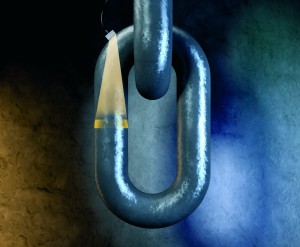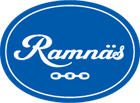Ramnäs Bruk has manufactured and supplied anchor chain to the international offshore industry since the 60’s. During the years Ramnäs Bruk has improved the production process in order to meet the new customer requirements and to use technical developments for automation and inspection. New methods of the production process bring an efficient production that cut our costs. Cooperation with the steel industry has improved the steel quality and new high-strength steel for higher grades and larger chain dimensions has been developed. Today our production capacity is 15 000 MT per year.
The four most important factors when producing high quality chains are;
(1) the material
(2) the welding procedure
(3) the heat treatment
(4) the inspection of the chain.
Ramnäs Bruk only use steelworks qualified and approved by the classification societies.
A short introduction and also a short movie of each part of the production can be found below.
Steel Quality
Ramnäs quality engineering steel is developed in cooperation with selected and certified steelworks. Different steel recipes are developed specific for different grades and sizes of chain. Together with the steel manufacturers Ramnäs Bruk is constantly trying to improve the steel properties. The goal is to make it even more optimal for our production and to improve our quality continuously. The steel manufacturer as well as Ramnäs Bruk has a rigorous Quality Control System that makes it possible to trace every single bar. Each heat and steel bar is certified before dispatched to Ramnäs.
Arrival Control
When the steel arrives to Ramnäs a thorough arrival control is made. The arrival control consists of checking the melt identification, checking the surface condition, dimension and tolerances etc.
Cutting the Bars
The bars are cut into smaller blanks. It is very important that you get the right length of the blanks because that will affect the final length of the link and consequently the whole length of the chain.
Electric Resistance Heating
The blanks are heated to the correct temperature that is optimal to bend the bars into links. The temperature is controlled both automatically and manually to assure that the right values are set.
Forming of Links
The heated blank is shifted into the bending machine and bent to a pre-formed link and connecting it to the previous link. The forging operator’s responsibility is to check the pre-formed link. The check is comprised of checking the symmetry and shank alignment.
Welding
Links are flash butt welded. The flash butt welding machine is pre-set according to data depending on chain grade and size (welding recipe). The welding recipe is set by the production engineer and stated in our monitoring system RChain. It is the responsibility of the operator to continuously check that the welding clamps are clean and have a snug fit.
Each flash butt weld is recorded and controlled by microprocessors. The main monitoring parameters are the current, voltage, sledge force and position.
Trimming
The flash butt weld burr is trimmed by a special removal tool working along the periphery of the weld. The cut surface aligns closely to the link surface. The forging operator is responsible for the trimming and the tool condition. Deburring stripes deeper than 0.5 mm are not allowed.
Shaping and Stud Mounting
Ramnäs Bruk’s stud mooring chain is fitted with drop forged studs. The asymmetrical design of the stud gives equal stud footprints and contributes to a symmetric stress-distribution in the link.
Hot Bend Test
Ramnäs demanding Hot Bend Test is beyond standard regulations. This test is performed on each different melt so we know that the welding parameters are correctly set.
Pre Heat Treatment Inspection
At this station we visually inspect the shape and surface of each link and we also do Magnetic Particle Examination of each link.
Heat Treatment
The purpose of the heat treatment is to give the chain and every link the best possible heat treatment, particularly to give the weld zone such a microstructure that the desired criteria for mechanical properties are the best possible and that all results are fulfilled. The treatment is performed in continuous automatically controlled furnaces and consists of austenitization and tempering, both operations followed by water cooling.
The furnace settings are given in RChain and the furnace operator reports in the RChain system.
The following data are continuously recorded by the furnace instruments:
– Furnace temperature, in each zone
– Water temperature
– Chain speed
Mechanical Testing
Mechanical testing samples are taken from the finished chain, in order to confirm that pertinent mechanical criteria are fulfilled.
The sample sets are retreived per the sampling frequency specified in the classification society rules and as a minimum from each melt of steel.
A normal set of test specimens taken from one sample consist of:
– One set for break test, three-link sample. For dimension above 132 mm dia according to DNV rules one link is break load tested.
– Tensile and impact tests, one link.
– Spare, one link.
The chain will not be proof loaded until mechanical tests and the break test have been approved.
The mechanical testing is performed according to the classification societies’ rules. The test results are recorded in our monitoring system RChain.
Proof- and Break Loading and Gauging
Three-link samples are load tested to the minimum breaking load.
The proof loading is performed by a continous testing machine, where 5-7 or 9 links are proof loaded with 2 links overlap. Every link is load tested to the proof load specified by the pertinent classification society. Three-link samples are load tested to the minimum breaking load. The proof loading machine does computerized recording of load and plastic elongation. The five link measurement is also done in the proof loading machine.
Controlled Stud Expansion
Ramnäs controlled stud expansion, performed after proof loading is the standard method in Ramnäs Bruk production process since 1991 and it replaces all forms of stud welding. The stud expansion fixes the stud and creates a spring effect that improves the fatigue life of the chain.
Shot Blasting
After the stud expansion the surface of the chain is cleaned by shot blasting it. This is not only done for getting nice looking chain but mainly because we need to have a clean surface when doing the NDT final inspection.
Final Inspection
The final inspection consists of two major Non Destructive Testing (NDT) methods, namely Magnetic Particle Inspection (MPI) and Ultrasonic inspection (UT).
Magnetic particle inspection
The purpose of the final magnetic particle inspection is to safeguard that no surface defects remains on the finished chain. The wet method is used in combination with fluorescent light. We have installed an Automatic Magnetizer to make the inspection more thorough, easier and of course quicker to perform. All links are checked in the most sensitive areas, the link surfaces which have been in contact with the electrode clamps of the welding machine, the weld itself and its vicinity. For chain diameters of 132 mm and above 10% of the links are subject to surface control of all accessible surfaces. The link identification established at the pre heat treatment control is utilized at reporting of the MPI-results in RChain. The inspection is performed by qualified and certified personnel.
Ultrasonic inspection with Phased Array method
The purpose of the ultrasonic inspection is to check the interior of the welded area on the link. Phased Array method uses ultrasonic waves with a large number of vibrations sources. The versatility and high speed of the PA method enables 100% check of all welds, with quicker and more accurate result than with traditional UT methods. UT results are reported in RChain. The inspection is performed by qualified and certified personnel. The Phased Array method is approved by all major classification socities.

Dispatch, Logistics and Transportation
After the chain has passed through the final inspection and the classification society dedicated to the project has cleared the chain and all the documents it is ready for shipment. The chain segments are bundled with wire slings according to customer requirements.
Depending on the size of the order, the chain will be shipped from Ramnäs by truck or most likely by train to either Gävle or Uddevalla port. From the port our chain leaves Sweden for its final destination anywhere in the world.
Project Management and Final Documentation
A delivery from Ramnäs often starts with engineering and detailed design. Every project gets a dedicated Project Manager that will be the customer’s link to Ramnäs. During the project the Project Manager will supply progress reports according to customer requests.
After delivery the customer will receive the final documentation as specified by the classification society and customer requirements.
